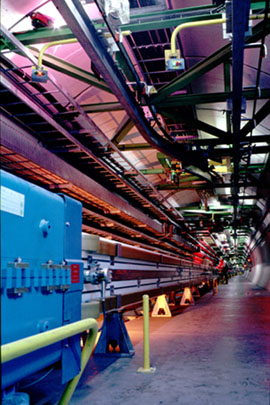Geneva, 14 September 2000. On 14 September 2000 CERN1's Director General Prof. Luciano Maiani, after a recommendation from the LEP Experiments Committee and the CERN Research Board, decided to extend the experimental run of the LEP accelerator until the 2nd November 2000. It was originally planned to conclude LEP's eleven year period of physics research at the end of September, and to begin the complex operations for the installation of CERN's new accelerator the Large Hadron Collider (LHC). However, exciting new results from the LEP experiments justify this change. The construction schedule for LHC will not be affected by this prolongation of LEP running.
Geneva, 14 September 2000. On 14 September 2000 CERN1's Director General Prof. Luciano Maiani, after a recommendation from the LEP Experiments Committee and the CERN Research Board, decided to extend the experimental run of the LEP accelerator until the 2nd November 2000. It was originally planned to conclude LEP's eleven year period of physics research at the end of September, and to begin the complex operations for the installation of CERN's new accelerator the Large Hadron Collider (LHC). However, exciting new results from the LEP experiments justify this change. The construction schedule for LHC will not be affected by this prolongation of LEP running.
One of LEP's main physics aims has been to search for the missing link of the standard model of particle physics, the Higgs boson. The Higgs mechanism is a part of the standard model that allows particles to have non-zero mass. Its central concept is a field that pervades the whole of space. Particles that interact with the Higgs field have mass, and their masses are determined by the strength of their interaction with the field. The Higgs boson is the particle associated with the oscillation of the Higgs field. In theory, the Higgs mechanism looks to be just what is needed, but the experimental evidence is still missing. No Higgs boson has yet been seen.
The history of Higgs searches at LEP goes back to 1989 when the accelerator was commissioned. During its first phase, from 1989 to 1995, LEP centre-of-mass energy was set at 91.2 GeV (the Z0 mass), and the searches resulted in a Higgs boson mass lower limit of 65 GeV. From 1996 onwards, Higgs searches at LEP continued with progressive energy increases reaching a maximum of 202 GeV in 1999. These successive increases of the centre-of-mass energy allowed the exclusion of a Higgs boson with a mass less than 108 GeV.
In April 2000 the stage was set for a final push. Everything was done to boost the energy of LEP's particle beams as high as possible. Excellent work by the CERN teams has allowed the accelerator to achieve energies up to 209 GeV, well beyond the original design energy. Significant experimental data started to be accumulated at a centre-of-mass energy in excess of 206 GeV, and a number of events compatible with a Higgs boson production with mass around 114-115 GeV was reported in the combined results of the four LEP experiments, ALEPH, DELPHI, L3 and OPAL. However, the topology of these events is also compatible with originating from other known standard model processes. As a consequence, it is at present impossible either to rule out or confirm the existence of a 114-115 GeV Higgs boson. The prolongation of the LEP running in October 2000 is the response to this intriguing situation. The extension, the maximum still compatible with the tight LHC construction schedule, will effectively double the experimental data at centre-of-mass energy above 206 GeV allowing the the possible Higgs boson signal at 114 GeV to be better tested. Higgs bosons of such a light mass will be copiously produced at the LHC, the centrepiece of the future scientific programme at CERN.
The decision to extend LEP's experimental programme sets the scene for a nail-biting finish to the accelerator's already illustrious career.
For possible Higgs candidate pictures, please see:
Aleph (jpg, ps) and Delphi (jpg, ps)

